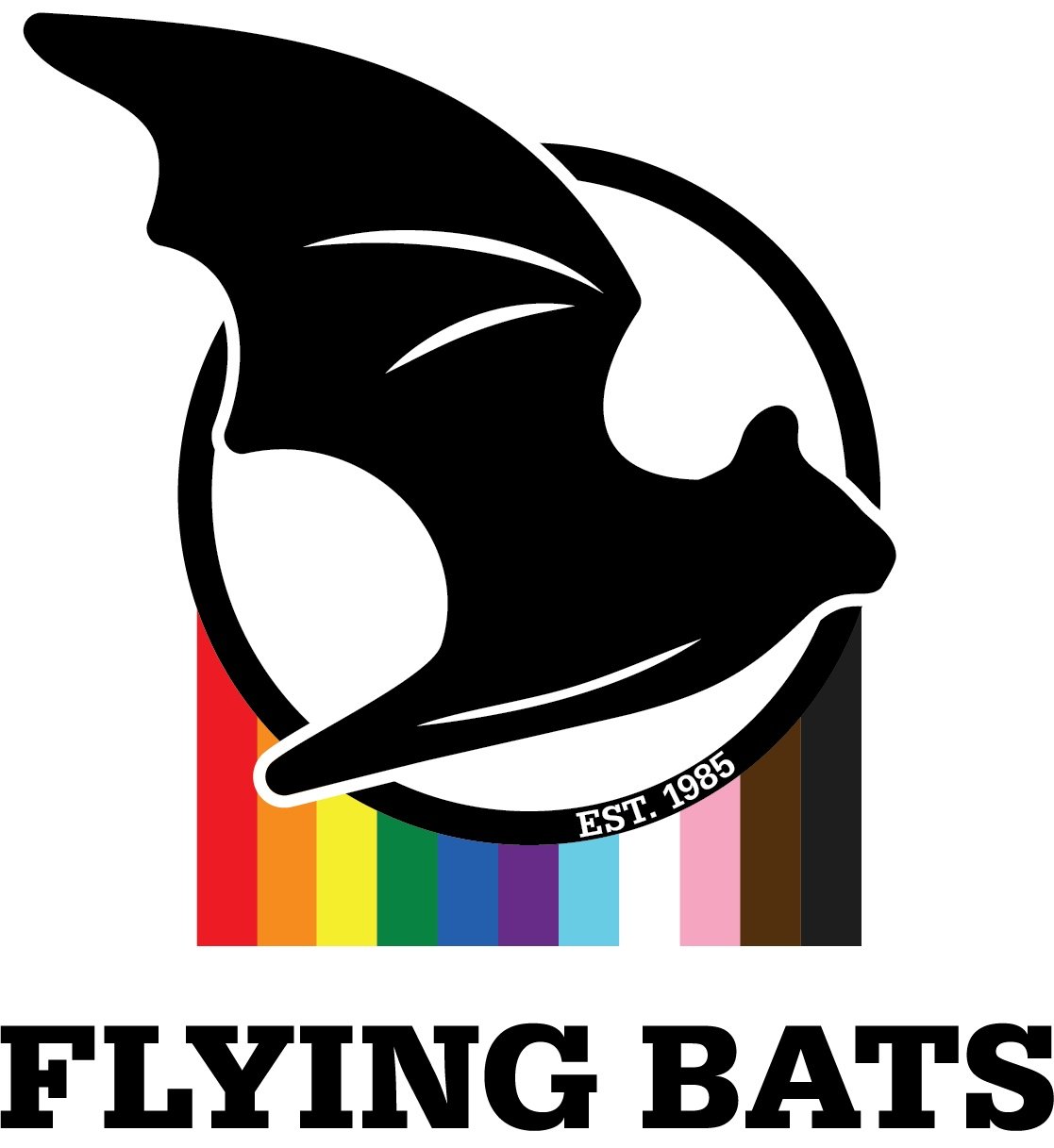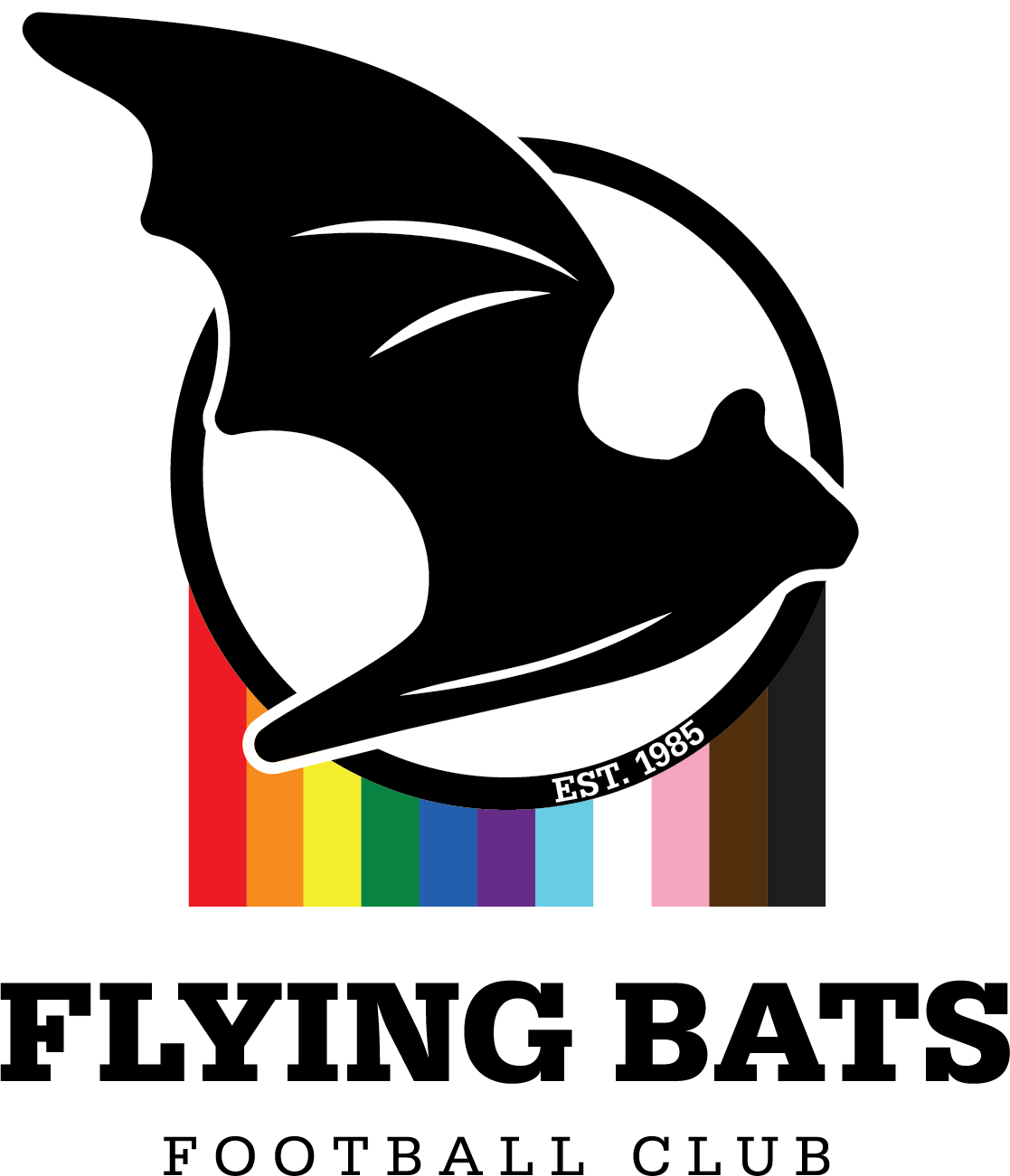Origins
The origins of the club were due to the initiative and energy of a small group of lesbians living on a Camperdown street in 1985.
Founding the club
Tracey Atkinson and her partner Alison Todd were amongst those pioneering women and played for the first few seasons. They remember the role of Linda Patterson and her partner as being absolutely pivotal in the founding the club. Tracey laughs as she recalls how a determined Linda “decided that she was going to get the soccer team together, so she rounded up anybody that could walk.”
There has been much speculation over the years about how the Flying Bats name was chosen. One interviewee, Sue Kerr, who played in the 1980s, heard that the name was chosen by Linda, her partner and others as they sat on the back porch of their home in the inner-west “and all these bats flew over so they said, ‘that’s a really good name for the club. Let’s call it the Flying Bats’ and that’s how it was named.”
Alison Todd highlights that in these early years “Linda was the backbone. Linda rounded up most people and she did all the organising. Linda made the T-shirts. Linda came up with the name I think…made the logo. She really was the driving force in terms of getting everything and everyone together.” Linda was a passionate advocate for women’s rights and for lesbian rights. Tracy Atkinson stresses that Linda “was always positive for women. It was always about women’s issues that she was trying to help and promote and lift.”
Remembering Linda Patterson
(aka Linda Lou Murphy) [1958-2009]
Outside of her commitment to the Flying Bats, Linda was an active performance artist in Sydney, often performing evocative and political street theatre. In 1986 she organised a subversive fashion parade in Heffron Hall, Darlinghurst called "Catwalk Talks" (reported in the Tribune newspaper, 17 December edition). The article caption reads "Fashion shapes women's bodies, and their minds as well". Hand-made garments were fashioned out of 'chux', cling wrap and other kitchen items - presumably as a comment on enforced gender roles.
Linda Patterson
Linda moved to South Australia after her time in the Flying Bats and from 1998 continued her art as part of Shimmeeshok, a performance group. She was instrumental in forming this group and in driving the creative direction of their performances. As part of Shimmeeshok, she continued her guerrilla street performances in Adelaide while she studied.
Described as a "sculptor of moments" by fellow artist Ali Baker, she undertook a Master in Visual Arts, graduating in 2009. Interestingly, her final collaborative performance piece was named 'Life of a bird, a life in performance' and the concept of flight and the air featured strongly in her work. In fact, she is noted for having a fascination with airborne creatures (...we can speculate both birds and Bats).
Prior to her death, Linda made a bequest to the University of South Australia for an arts scholarship for disadvantaged or isolated students. As remembered in her catalogue of work (published by SASA Gallery), Linda's own childhood experiences made her acutely aware of people facing hardship and she was passionate about supporting people in times of adversity.
Playing in the Early years
Anne Himmelreich, an early player with the Flying Bats, remembers the strong sense of community that united players. She explains how joining the Flying Bats was part of her coming out story and stresses that it “was wonderful to meet other lesbians rather than just the one or two I knew. It was so important to for me. It was just heavenly to meet all these lesbians and think I’m not the only gay in the village.” She also recounts how a team with "short, back and sides" was perhaps perceived by those in the early soccer association.
There was only one Flying Bats team when the Club was originally formed as part of the eastern suburbs association, with the Club growing significantly over the last three decades to field up to seven teams more recently. In these early years, the official Club colours were not the current black and red but were blue and black. Fran Krix, who recalls joining in the Club’s second year, describes how t-shirts were made “on the cheap…we used to get the sheets of the material to cut numbers out to sew them on.” There was no formal Club structure with players thinking of themselves as being part of a collective.
Left to right - Back row: (?), Linda Patterson, Ann, Tracey Atkinson, (?), Anne Himmelreich, Nancy. Front row: Dot
For those early players, who in the first year formed one team, fitness and a chance to socialise were the prime motivations for joining the club. Many of the women who played in the first decades of the Bats had not had any previous soccer experience. Tracey says “it was really kick and giggle; we weren’t as competitive as we should have been.” She remembers “a lot of the time, we’d kick our own goals…it was pretty funny. Honestly…you could have been the average age of the first team was around 30, perhaps a little older than was typical."
Training in the first years took place in Lilyfield. Tracey Atkinson remembers there were challenges in these early years. “That was where we used to practice but unfortunately, even though we were very diligent with the council to say, we’re going to be practicing here every Thursday night starting at whatever time it was, five o’clock or something, they never had the lights on for us.” Alison Todd confirms “so we used to train in the dark.”
Bats vs Crones
Competitors included the Crones, another lesbian football team and possibly the first of its kind in Australia. Their early colours included bright pink t-shirts and interviewees recounted memories of the their logo - a witch in a gay solidarity triangle.
They disbanded after some time and several Crones players were absorbed into the Flying Bats. Interviewees indicated that the Crones were a more competitive club on the field and, similar to the the Bats, were influenced by the feminist and lesbian separatism movements of the time.
The Flying Bats (in blue) play the crones (in pink) on 20 July 1986 in Sydney. Donated by Tracey Atkinson and Alison Todd.
Two Bats teams
Competitors included the Crones, another lesbian football team and possibly the first of its kind in Australia. Their early colours included bright pink t-shirts and interviewees recounted memories of the their logo - a witch in a gay solidarity triangle. They disbanded after some time and several Crones players were absorbed into the Flying Bats. Interviewees indicated that the Crones were a more competitive club on the field and, similar to the the Bats, were influenced by the feminist and lesbian separatism movements of the time.
Left to right - Back row: Yolanda, Chrissie, Michelle Brown, Karen, Sue Kerr. Middle row: Jane Castle, Fran Krix, Ingrid Cullen, Angela. Front row: (?), Hajar, Jenny. (And Juno the dog!)
Socialising and celebrations
Bar Italia in Leichhardt was a popular place to socialise at the end of games in the early years and became the Club’s first sponsor. Fran Krix reminisces it “was a really nice way to end a game…” She does not remember Bar Italia fully acknowledging sponsorship of the club but “they forked out uniforms for two teams.”
Ingrid Cullen, the first woman to coach the Flying Bats and who also played with Fran Krix, points out that Bar Italia did not expect much in return for this. She explains, “We put their name on t-shirts and gave them patronage each week.”
Shirt donated to the Australian Gay and Lesbian Archives (ALGA) by Claudia Taranto
At the end of each season, there would be major celebrations, a tradition which has been continued over the years. Alison Todd remembers during the early years, “there’d always be a big party at the end, which was always a real highlight, and it was great fun, and there would be awards for everybody in the team and there were beautiful cups” which Linda, a talented artist, put great effort into designing. Recognition of Club supporters, including the presence of partners and parents at the games was a feature from the early years. Tracey's mother, Val, received 'Our Most Committed Supporter' medal in 1986, which similar to the trophies and uniforms were often repurposed and hand-made.
The Flying Bats Women's Football Club was formed as a means of providing women with a sense of support and community at a time when options were limited and lesbians were subjected to multiple forms of prejudice and discrimination. Memories from women who played in these early years emphasise finding support and friendship and a place where women from diverse backgrounds could find acceptance and a sense of belonging.














